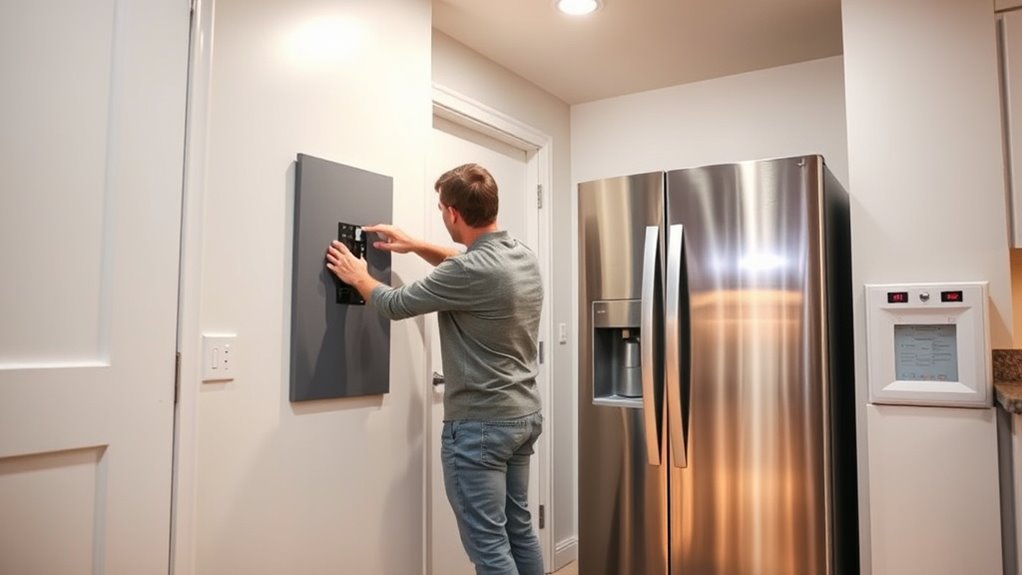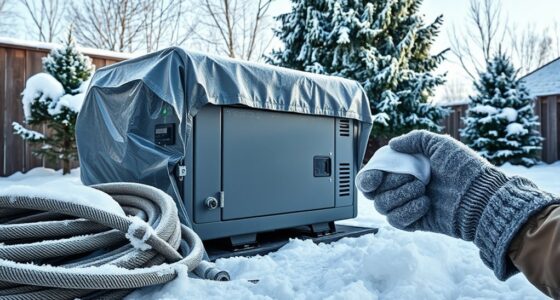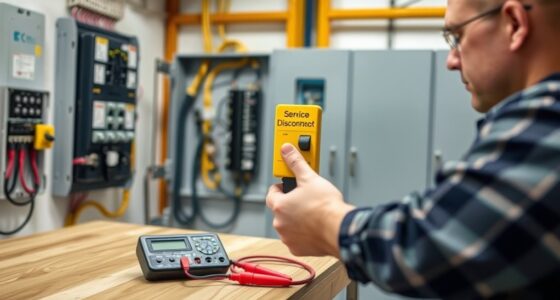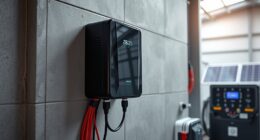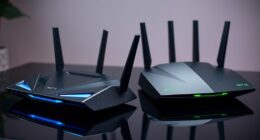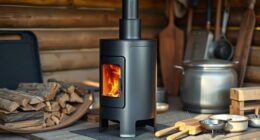After a power outage, wait a few minutes to let your system stabilize before reconnecting appliances. Start with essential devices like your refrigerator or medical equipment, reconnecting them gradually and one at a time. Observe for any sparks, unusual noises, or circuit breaker trips. Be cautious with your HVAC system, turning it on after full power is confirmed. If you pay attention to these steps, you’ll guarantee safe and effective restoration—learn more to keep your home safe.
Key Takeaways
- Wait 15-20 minutes after power restoration for voltage stabilization before reconnecting appliances.
- Reconnect critical devices first, using surge protectors and avoiding overloads.
- Gradually restart appliances, spacing out restarts by at least 5-10 minutes.
- Turn off HVAC and appliances before power restoration, then turn on thermostats and circuits slowly.
- Inspect all devices for damage, and monitor for abnormal sounds, sparks, or failure during reactivation.
Wait and Monitor Before Reconnecting Devices

After power returns, it’s also advisable to check your electrical system for any signs of damage or anomalies before reconnecting sensitive devices. During this time, test lights and non-critical devices to confirm the power is fully restored. Reconnecting everything at once can cause sudden surges that may damage appliances or trip breakers again. Reconnect gradually, spreading out the electrical load. Also, delay plugging in sensitive electronics until voltage fluctuations settle. This careful approach safeguards your devices from potential harm. Additionally, monitoring voltage stability can help identify fluctuations that might harm your electronics. Conducting a brief visual inspection of your electrical outlets and wiring can further prevent potential hazards. Performing a load assessment can help ensure your system handles the reconnected devices safely. Be patient, and avoid rushing the process to ensure a safe and smooth restart for your appliances and home systems.
Reconnect Essential Appliances First

Start by reconnecting critical appliances like your refrigerator, freezer, and medical devices to protect food and health needs. Power each device gradually, waiting a few minutes between connections to prevent surges or overloads. Keep an eye out for any issues or unusual signs as you restore power in stages. Understanding your home’s power distribution devices can help you identify the safest sequence for reconnecting appliances and avoid potential hazards. Additionally, being aware of industry trends can inform you about modern solutions for targeted skin care, which, while unrelated, emphasizes the importance of proper application and timing for best results. Incorporating load‑planning tools can further enhance your safety by ensuring your home’s electrical system is not overwhelmed during restoration.
Prioritize Critical Devices
Prioritizing critical devices guarantees your home remains safe and functional after an outage. Start by reconnecting refrigerators and freezers to prevent food spoilage and protect essential medications. These appliances usually need between 600 and 1,200 watts, so verify your power source can handle their startup surges. Next, restore medical devices like oxygen machines, ventilators, or CPAPs, which are essential for health and typically require 100 to 400 watts. Reconnect lighting to ensure safe navigation, especially at night, and consider sump pumps if you have basements or crawl spaces to prevent flooding. Check the wattage demands and verify your backup power can support these essentials without overload. Understanding the wattage requirements of appliances is crucial for safe reconnection. Prioritizing these devices guarantees safety, preserves crucial resources, and helps restore your home efficiently.
Reconnect in Stages
Once you’ve identified which appliances are most essential for safety and daily function, reconnecting them carefully helps prevent electrical overloads. Wait 15-20 minutes after power is restored to let the system voltage stabilize. Reconnect appliances one at a time, starting with critical devices like the refrigerator and HVAC systems, then moving to less essential items. Use surge protectors for sensitive electronics and avoid plugging multiple devices into a single outlet or power strip. To ensure safety, visually inspect appliances and cords for damage before reconnecting, and reset digital settings as needed. Prioritizing essential appliances reduces the risk of overloads and protects your system. Being aware of electrical safety practices can further minimize hazards during the restart process. Additionally, understanding the importance of proper circuit management can help prevent future outages or damage. Recognizing the role of home wiring in overall electrical safety can also contribute to more efficient system restarts. Remember, patience and caution are key to a safe and effective restart process.
Monitor for Issues
After power is restored, it’s crucial to carefully monitor your essential appliances for any signs of malfunction or damage. Watch for abnormal sounds, sparks, or failure to operate, which could indicate internal issues. Check that refrigerators and freezers are cooling properly; discard perishables if temperatures stay unsafe beyond recommended times. Keep an eye on circuit breakers; if they trip frequently, it may signal overloads or short circuits. Use surge protectors on sensitive electronics to guard against voltage spikes. Inspect HVAC systems for proper airflow and cycling, ensuring they run smoothly. If you notice burning smells, smoke, or strange noises, unplug the appliance immediately and seek professional help. Proper monitoring helps prevent further damage and ensures your appliances are safe to use. Additionally, regularly inspecting electric heated mattress pads can prevent overheating and ensure safe operation. It is also beneficial to verify that your air purifiers are functioning correctly, especially since power outages can affect their filters and performance. Ensuring filter maintenance is up to date can help maintain indoor air quality after an outage. Being aware of smart appliance malfunctions can help you troubleshoot issues early and avoid costly repairs.
Gradually Add Non-Essential Devices

Once your essential appliances are running smoothly, start reconnecting your non-essential devices gradually. Space out their activation to prevent overloads and watch for any signs of electrical issues. Prioritizing this process helps make certain your system stays stable and avoids potential damage.
Prioritize Essential Appliances
When restoring power following an outage, it’s essential to reconnect essential appliances first to guarantee safety and preserve critical resources. Start by plugging in devices like refrigerators, freezers, and medical equipment, then wait a few minutes before adding others. This approach helps prevent electrical surges and overloads. To guarantee safety and efficiency, consider these steps:
- Reconnect high-priority appliances like refrigerators and medical devices first.
- Wait for a stable power load before plugging in non-essential devices.
- Avoid powering multiple high-wattage appliances simultaneously to prevent tripping breakers.
- Using self-watering plant pots as an analogy, ensure each device has adequate time to stabilize before adding more to prevent overloads and protect your home’s electrical system.
- Additionally, understanding the importance of proper angle adjustments can help prevent damage to sensitive appliances during startup.
Space Out Reconnection
Reconnecting appliances gradually helps maintain a stable electrical system and prevents overloads. By spacing out when you turn devices back on, you avoid sudden high power demands that can trip circuit breakers or cause voltage drops. This approach also reduces the risk of power surges damaging sensitive electronics. Start by reconnecting major appliances, waiting at least 5 to 10 minutes between each to balance the load. Smaller devices, like lamps and chargers, can be added once critical systems are stable. For HVAC systems, allow 1 to 1.5 hours between restarts to let compressors warm up and prevent damage. Keep non-essential electronics, such as entertainment systems, disconnected until you’re confident the essential loads are stable and the system isn’t experiencing issues. Incorporating electrical safety practices during this process can further protect your appliances and system integrity. Additionally, understanding juice detox principles can help you maintain energy and wellness during stressful times like power outages.
Monitor for Issues
After essential appliances are restored and the electrical system stabilizes, it’s important to carefully monitor for issues before adding non-essential devices. Pay close attention to how your appliances behave as you reconnect them. Look out for abnormal sounds, strange smells, or flickering lights, and unplug any device showing signs of damage immediately. Use surge protectors for sensitive equipment and connect devices gradually, starting with less critical ones. Keep an eye on circuit breakers and ensure no overloads occur. Additionally, check that appliance displays and settings function correctly, and verify that ventilation areas are clear. By monitoring each step, you can catch potential problems early, preventing further damage or fire hazards. Always prioritize safety over speed when restoring your household’s electrical system. Incorporating proper electrical load management can help prevent overloads and ensure a safer recovery process.
Observe Appliance Functionality and Safety Signs

Before restarting appliances following an outage, it’s essential to perform a thorough visual and sensory inspection to guarantee safety and proper function. Check for visible damage like cracks, frayed wires, or melted insulation. Smell for burning or unusual odors that might signal electrical issues. Listen for unusual noises or sparking when turning appliances on; unplug immediately if detected. Examine your electrical panels for sparks or smoke. Use the table below to guide your inspection:
| Damage Signs | Safety Indicators | Immediate Action |
|---|---|---|
| Cracks, frayed wires | Burning odors, smoke | Unplug and consult a pro |
| Water infiltration | Sparks, buzzing sounds | Turn off power before inspection |
| Unusual appliance behavior | Sparks, flickering lights | Avoid using until checked |
| Overheating or melting | Unusual smells, discolored parts | Seek professional evaluation |
Additionally, ensuring your electrical system is properly tuned and maintained can prevent issues like short circuits that may occur after power outages.
Handle Refrigeration and Food Safely

When restarting your refrigeration, keep the doors closed tightly to preserve cold temperatures and prevent spoilage. If you’re unsure about the safety of certain foods, it’s best to discard any items that seem spoiled or have unusual odors or textures. Removing and disposing of spoiled foods promptly helps protect your household from foodborne illnesses.
Keep Doors Closed Tight
Keeping refrigerator and freezer doors tightly closed during an outage is essential for maintaining cold temperatures and preventing food spoilage. When doors stay shut, a refrigerator can keep food cold for about 4 hours, while full freezers can stay frozen for roughly 48 hours. Half-full freezers last about 24 hours. Minimizing door openings limits warm air entry, slowing temperature rise and bacterial growth. To maximize cold retention, consider these tips:
- Avoid opening doors unnecessarily.
- Use dry ice or ice blocks to extend cold preservation.
- Record temperature readings once power is restored.
Discard Uncertain Foods
How can you determine if leftover or perishable foods are safe to eat after a power outage? First, check your appliance thermometers to confirm temperatures. If there’s no thermometer, look for ice crystals in packages; their presence indicates the food is safe to refreeze or cook. Discard foods that have been above 40°F for more than 2 to 4 hours, especially meat, dairy, eggs, and leftovers. Foods between 40°F and 45°F should be cooked and eaten promptly, not refrozen. Visual and odor checks aren’t reliable indicators of safety. Remember, foods that stayed cold below 40°F are usually safe, but once they’ve exceeded safe holding times, it’s best to discard them to avoid foodborne illness. When in doubt, throw it out.
Remove Spoiled Items
After a power outage, it’s essential to promptly remove any spoiled or unsafe items from your refrigerator and freezer to prevent cross-contamination and foodborne illness. Check all perishables closely, discarding items that have been above 40 °F for over four hours, or those with damaged packaging, unusual odors, or discoloration. Use a thermometer to verify temperatures, and remember that food with ice crystals or kept at 40 °F or below may still be safe.
- Discard foods exposed to floodwaters or stormwater contamination
- Throw away items in bulging, leaking, or damaged packaging
- Dispose of perishable foods that have been above 40 °F for over four hours
Restarting HVAC Systems Properly

Restarting your HVAC system after a power outage requires careful steps to guarantee safety and proper operation. First, turn off the thermostat to prevent the system from starting prematurely. Switch off the power at the circuit breaker dedicated to your HVAC unit to avoid power surges. If your outdoor unit has a reset button, press it; not all units have this feature. Wait at least 30 minutes after power is restored to allow internal circuitry to reset and stabilize. Before turning the system back on, double-check that the circuit breaker is properly reset and that all disconnect switches are in the “on” position. If your system doesn’t start or shows signs of trouble, contact a professional HVAC technician for assistance.
Managing Heat Pumps and Emergency Heating

Managing heat pumps and emergency heating systems effectively after a power outage is vital to prevent damage and guarantee reliable operation. First, verify power is fully restored and circuit breakers are on before attempting any reset. Use the unit’s reset button near the outdoor unit or thermostat if available; if not, turn the breaker off for 30 seconds to 30 minutes to allow components to stabilize. Avoid rushing the restart to prevent system damage. After restarting, check for error codes or unusual noises to confirm proper function.
- Confirm power is stable before resetting
- Wait the recommended time before restarting
- Inspect for error codes or strange sounds
Following Generator Shutdown Procedures

Following proper generator shutdown procedures is essential to guarantee safety and equipment longevity. First, disconnect all electrical loads to prevent surges. Allow the generator to run for one to three minutes without load to cool down and avoid thermal shock. Use the control panel to activate the shutdown switch or button, holding it if necessary, as per the manufacturer’s instructions. Close the fuel supply valve if available to reduce fire risk, and disconnect the battery if instructed. Switch off the circuit breaker to isolate the generator from your home’s electrical system. Verify that no appliances or HVAC systems are drawing power. Lock and secure the generator enclosure to prevent accidental operation and protect it from wind or debris. Following these steps ensures a safe and effective shutdown.
Ensuring Electrical Safety During Extended Outages

During extended outages, ensuring electrical safety is critical to prevent injuries and equipment damage. First, unplug all appliances to avoid power surge damage when electricity returns. Turn off breakers or remove fuses during the outage to minimize electrical risks. Keep one lighting circuit operational to easily detect when power resumes without overloading the system. Verify that extension cords and connections are properly rated and in good condition to prevent fires or shocks. Always maintain a safe distance from downed power lines and report them immediately. Avoid contact with flooded electrical equipment until inspected. Use generators outdoors, at least 20 feet away from windows and doors, to prevent carbon monoxide poisoning. Following these safety steps keeps you protected during prolonged outages.
Preparing for Future Power Interruptions

Preparing for future power interruptions involves investing in reliable backup energy solutions that can keep your home running smoothly. Solar panel systems with battery backups store renewable energy and operate silently with minimal maintenance, unlike generators. These systems can work independently of solar panels, providing energy independence and boosting your property value. Benefit from federal tax credits offering up to a 30% rebate on solar battery installations through 2032. To protect food and water, minimize fridge and freezer door openings, use coolers with ice, and store perishables outdoors in winter if safe. Keep essential supplies like flashlights, batteries, bottled water, warm clothing, and ice packs on hand. Turn off major appliances during outages, leave one light on to signal power restoration, and develop an outage plan to stay prepared and safe.
Frequently Asked Questions
How Do I Identify if My Appliances Are Safe to Restart?
You check if your appliances are safe to restart by inspecting for visible damage like frayed wires, burn marks, or water exposure. Listen for unusual noises, smells, or sparks when turning them on. Confirm controls and indicators work correctly. Unplug high-power devices before power restores, and wait at least 5-10 minutes after the outage to reconnect appliances gradually. If you notice damage or irregularities, call a professional before using the appliance again.
What Are the Signs of Electrical Instability During Power Restoration?
During power restoration, watch for flickering or dimming lights, buzzing sounds from outlets, and discoloration around sockets. If outlets or switch plates heat up or emit odd smells, it’s a sign of electrical issues. Frequent breaker trips, unstable appliance operation, or sudden surges indicate instability. If you notice these signs, avoid using affected circuits and contact a licensed electrician or your utility provider immediately to prevent hazards.
When Should I Call a Professional for HVAC or Generator Issues?
You should call a professional if you notice strange noises, burning smells, or visible damage like leaks or corrosion. When your system fails to restart, cycles excessively, or produces error codes, expert help is vital. If you experience inconsistent airflow, unusual odors, or your energy bills spike unexpectedly, a technician can diagnose and fix underlying issues. Don’t risk safety—trust professionals to guarantee your HVAC or generator operates reliably and safely.
How Long Should I Wait Before Reconnecting Sensitive Electronics?
You should wait at least 10-15 minutes after power is restored before reconnecting sensitive electronics. This pause helps prevent damage from power surges caused by grid stabilization. During this time, allow essential appliances to stabilize and reconnect devices gradually, one at a time. Using surge protectors adds extra safety. If you notice anything unusual, unplug devices immediately and seek professional help to avoid further damage.
What Safety Precautions Are Necessary When Handling Fuel for Generators?
Picture fuel as a volatile spark waiting to ignite chaos. You must manage it with care. Always turn off and let the generator cool before refueling. Use nozzles with shut-off valves to prevent spills, and store fuel in approved containers away from heat and ignition sources. Keep a fire extinguisher nearby, clean up any spills immediately, and never siphon fuel. These steps ensure your safety and protect your environment from harm.
Conclusion
Once the power returns, think of your home as a symphony coming back to life. Reconnect devices patiently, like tuning instruments before the grand performance. Watch for signs of safety and proper function, ensuring everything hums smoothly. Handle your appliances with care, safeguarding your food and comfort. With cautious steps, you’ll bring your home back online, turning chaos into calm—like a skilled conductor guiding your household back into harmony after a storm.

